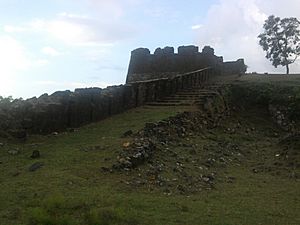Siege of Bednore facts for kids
Quick facts for kids Siege of Bednore |
|||||||
|---|---|---|---|---|---|---|---|
| Part of the Second Anglo-Mysore War | |||||||
 Remains of Bednore fort |
|||||||
|
|||||||
| Belligerents | |||||||
| Commanders and leaders | |||||||
| Strength | |||||||
| 600 Europeans and 1,000 Indian sepoys | 2,000 French and 100,000 Mysore troops | ||||||
| Casualties and losses | |||||||
| 500 | Unknown | ||||||
The Siege of Bednore was an important battle during the Second Anglo-Mysore War. This war took place between the British (including the British East India Company) and the Kingdom of Mysore. The British had taken control of Bednore, a town now called Nagara, and other areas in early 1783. This happened while the leader of Mysore, Tipu Sultan, was away fighting in another region.
The British commander, Brigadier-General Richard Matthews, left a small group of 1,600 soldiers in Bednore. He sent the rest of his troops to gather supplies from nearby areas. Tipu Sultan quickly brought his large army of over 100,000 soldiers back to Bednore. He surprised the British by arriving very close to the town on April 9. Matthews tried to fight Tipu Sultan's army outside Bednore but was quickly defeated. He had to leave the town and retreat to the fort, which was then surrounded by the Mysore army.
Matthews' soldiers lost much of their ammunition when they retreated. They also did not have enough food. Many soldiers became sick. On April 24, Matthews agreed to a ceasefire with Tipu Sultan. A few days later, on April 28, the British surrendered. The terms of surrender seemed fair at first. The British soldiers were allowed to march out with "honours of war." This meant they could keep their pride and some weapons. They were also promised safe travel to Bombay. However, Matthews secretly divided the army's money among his officers instead of handing it over. This made Tipu Sultan very angry.
What Led to the Siege
Bednore, known today as Nagara, is located in the Malabar Coast area of South-Western India. It was a strong fort for the Nayakas of Keladi rulers. But in 1763, Hyder Ali, Tipu Sultan's father, defeated them. He took over the area and made it part of the Kingdom of Mysore. Ali took a lot of treasure from the town and renamed it Hydernuggur.
The area was peaceful until the Second Anglo-Mysore War began in 1780. This war was fought between Hyder Ali (and later his son Tipu Sultan) and the British. In early 1783, Tipu Sultan's army was fighting near India's east coast. The British East India Company sent Brigadier-General Richard Matthews to the Malabar Coast. Matthews captured all the Mysore forces there. He then started to take supplies from the area, splitting his soldiers into small groups.
The Siege Begins
Tipu Sultan decided to stop his fighting on the east coast and return to the Malabar Coast. Matthews' soldiers were spread out and more interested in finding supplies than watching for enemies. Tipu Sultan's army was very large, with 2,000 French soldiers and 100,000 Indian troops. The British did not see them until April 9. By then, Tipu Sultan's army was only 4 miles (6.4 km) from Bednore.
Matthews could not gather all his scattered soldiers in time. Still, he chose to fight Tipu Sultan in an open field outside Bednore. Matthews' army had about 600 European soldiers and 1,000 Indian sepoys (Indian soldiers serving the British). They suffered 500 casualties in just a few minutes. Matthews then left the town and quickly retreated to the fort.
Much of the British army's ammunition was kept in the town. This was lost when they retreated. The soldiers inside the fort also had very little food. The fort's defenses were old and not in good shape. The Mysore army brought up their cannons and began to attack the fort.
Surrender and Aftermath
As more British soldiers became sick, Matthews arranged a ceasefire with Tipu Sultan on April 24. Two days later, he met with his officers. They all agreed to surrender. The terms of surrender allowed the British soldiers to travel safely to Bombay. Their sick and wounded would also be taken care of. One hundred sepoys could keep their weapons to protect the group on the way to Sadashagur, where they would board ships. On April 28, the British soldiers marched out of the fort with "honours of war." They placed their weapons down outside the fort.
The British soldiers were then marched to a water tank, where they were held for several days. On May 1, the regular soldiers, their wives, and camp followers were searched. Any valuable items were taken by the Mysore army. The officers were allowed to keep their personal belongings. However, all public money and supplies were supposed to be given to the Mysore army. Matthews had secretly divided the army's money, including items taken from the town, among his officers.
Matthews and some of his senior officers were called to meet Tipu Sultan. They were then taken captive. A search found most of the missing money. Matthews and 19 of his most senior officers later died under mysterious circumstances.
The sick and wounded British soldiers at Bednore were treated badly by the Mysore army. The flags of three British regiments were also taken on May 3.
The 34 junior British officers were put in chains and marched to a prison at Chittledroog (modern day Chitradurga). They were treated poorly, and some died during the journey. John Le Couteur, who later became a general, was one of these officers. He wrote about the campaign in 1790. The officers were offered their freedom if they joined the Mysore Army, but none of them did. Some sepoy non-commissioned officers who refused to join were believed to have been killed. The surviving prisoners were set free in March 1784. This happened as part of the Treaty of Mangalore, which ended the war.

